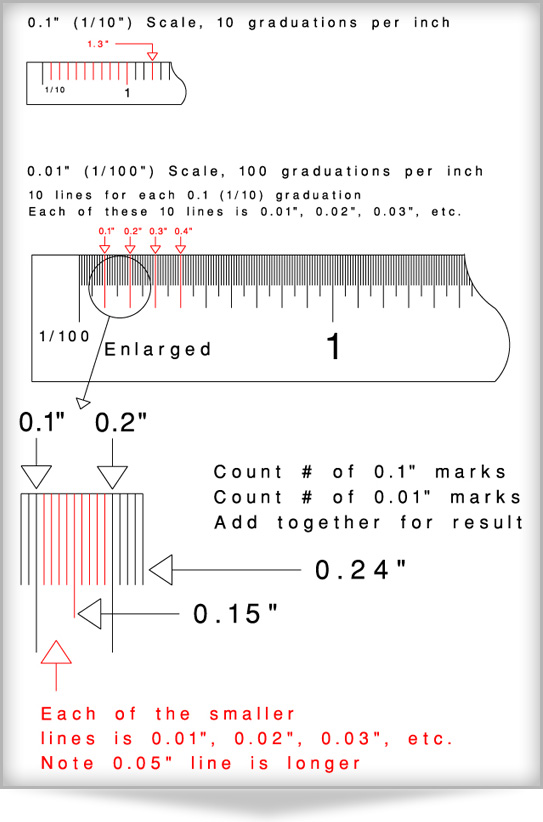A decimal ruler is a handy tool used to measure and calculate distances in decimal units, specifically inches. It is a must-have for anyone who works with measurements, whether it’s for a DIY project, crafting, or any other application that requires precision.
How to Use a Decimal Ruler (Inches)
 Using a decimal ruler is quite simple and straightforward. It consists of a linear measurement scale divided into inches, each further divided into smaller increments denoting fractions of an inch. Here’s a step-by-step guide on how to use a decimal ruler:
Using a decimal ruler is quite simple and straightforward. It consists of a linear measurement scale divided into inches, each further divided into smaller increments denoting fractions of an inch. Here’s a step-by-step guide on how to use a decimal ruler:
- Start by ensuring that your decimal ruler is clean and in good condition. Dust or debris on the ruler may affect the accuracy of your measurements.
- Identify the zero point. This is usually the end of the ruler from which the measurements start. Place the zero point of the ruler on one end of the item you wish to measure.
- Read the measurement. Look for the nearest marking on the ruler to the other end of the item. Each inch is further divided into smaller lines, indicating fractions of an inch.
- Estimate fractional measurements. If the object you’re measuring extends beyond a whole inch, you’ll need to estimate the fraction. Each smaller line between two whole-inch numbers denotes a specific fraction, such as half an inch (½), a quarter of an inch (¼), or an eighth of an inch (⅛).
- Record the measurement. Once you have determined the whole inches and estimated the fraction, write down the measurement in decimal form. For example, if your item extends to the third line beyond the 1-inch mark, and you estimate it to be about halfway between the two lines, the measurement would be 1.5 inches.
Reading a decimal ruler accurately may take some practice, but with time, you’ll become more comfortable and proficient in using this essential measurement tool.
Decimal Ruler for Dummies
 If you’re new to using a decimal ruler or need a refresher, there are various resources available to help you understand its functionality and make accurate measurements. One excellent resource is the book “Decimal Ruler for Dummies.” This practical guide provides step-by-step instructions, illustrations, and tips for getting the most out of your decimal ruler.
If you’re new to using a decimal ruler or need a refresher, there are various resources available to help you understand its functionality and make accurate measurements. One excellent resource is the book “Decimal Ruler for Dummies.” This practical guide provides step-by-step instructions, illustrations, and tips for getting the most out of your decimal ruler.
“Decimal Ruler for Dummies” covers everything from the basics of reading a decimal ruler to advanced measurement techniques. It explains the significance of each marking on the ruler, such as halves, quarters, eighths, and sixteenths of an inch, ensuring that you can confidently measure objects of all sizes.
In addition to the book, numerous online tutorials and videos can guide you through the process of using a decimal ruler effectively. These resources often include interactive examples and quizzes to help you practice your skills and reinforce your understanding of decimal measurements.
Printable Rulers in Actual Size
:max_bytes(150000):strip_icc()/teacherspayteachers-5aeb48dca474be0036fa3062.jpg) If you’re in need of a physical ruler but don’t have one readily available, don’t worry! You can find a wide variety of printable rulers online. These printable rulers are designed to be printed on standard letter-sized paper and provide accurate measurements when printed to scale.
If you’re in need of a physical ruler but don’t have one readily available, don’t worry! You can find a wide variety of printable rulers online. These printable rulers are designed to be printed on standard letter-sized paper and provide accurate measurements when printed to scale.
By using printable rulers, you can ensure that your measurements are precise, even if you don’t have access to a physical ruler. These rulers typically include both metric and decimal inch measurements, making them versatile for a range of projects and applications.
Whether you prefer a classic wooden ruler or a digital measurement app on your phone, having a decimal ruler at your disposal is essential for accurate measurements. So next time you embark on a DIY project or need precise measurements for any task, make sure to have a decimal ruler handy.
Remember, practice makes perfect when it comes to using a decimal ruler. The more you familiarize yourself with this tool and its markings, the more comfortable and confident you’ll become in measuring and calculating with precision.
So go ahead, grab your decimal ruler, and start measuring!